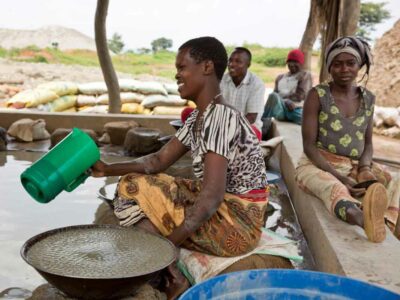
Tackling the Smuggling and Money Laundering in ASM Gold is a must
BY CARLA NEEFS
TDI Sustainability and Solidaridad have partnered for this blog series, reflecting on insights gained from a recent research report commissioned by Solidaridad and carried out by the Global Initiative against Transnational Organized Crime; and TDI’s ongoing research in this field, funded by planetGOLD, as well as drawing from our first-hand experience through building The Impact Facility for Sustainable Mining Communities, enabling blended finance solutions for ASM. In this series of blog articles, we aim to share important insights into this complex arena and analyse the challenges and possible solutions.
This blog series is based on a recent research report commissioned by Solidaridad and carried out by the Global Initiative against Transnational Organized Crime; and our ongoing research in this field funded by planetGOLD, and first-hand experience with our global grant and impact investment vehicle, The Impact Facility for Sustainable Mining Communities. In this second blog, we look at the ways in which ASM gold is being taken up into illicit supply chains
THE ROLE OF ILLICIT ACTORS IN ASM GOLD
The Solidaridad research reveals several mechanisms by which ASM gold becomes a part of the illicit supply chains:
Providing investment financing: Illicit intermediaries provide ASM with the necessary means to start and maintain their production of gold. Loan conditions, however, are unfavourable and miners get indebted to these illicit intermediaries.
Providing additional financial services: Illicit parties are also known to make financial support available in times of hardship in the mining communities. An example is providing money for medicines. This strengthens their relations with the local communities and is an incentive for communities to keep the status quo.
Providing transportation services: Local buyers are closely positioned to the ASM mine sites and able to collect the gold at the site themselves. For miners, this can be an attractive deal, because they often lose more in transportation costs – both time and money – than they do through selling gold for slightly lower prices at the mine site.
The most important reason for miners to engage with illicit buyers is the competitive price they offer. Illicit buyers are able to do so because they don’t pay royalties or other fees, don’t incur due diligence costs, and benefit from indirect trade links. Furthermore, gold may be more valuable as a vehicle to manage currency risks or launder money than as a commodity on the mainstream market.
It is estimated that the formal sector can only pay miners the LBMA fix minus 10% (LBMA sets the international standard for the market prices of precious metals), while informal and illicit traders could potentially offer up to the LBMA fix minus 5%. The research carried out by the Global Initiative and Solidaridad has concluded that the presence of illicit actors can create, perpetuate or increase the harms linked to ASM gold mining. After all, illicit actors are primarily concerned about maximizing their profits and have little interest in minimizing the harms
THE URGENCY OF TACKLING ILLEGAL TRADE ROUTES
The current price of gold on the international market is around 40,000 euros per kilogram and the price is steadily increasing. In the meantime, there is a relatively weak enforcement of regulatory frameworks in producing countries as well as in several global gold trading hubs, such as India and Dubai. This has led to ASM gold trading becoming a highly lucrative and low-risk business for illicit actors. The Canadian NGO Impact recently published an alarming study on the illicit trade routes to and from India, indicating Dubai as the largest source of smuggled refined gold for India.
JOINING FORCES FOR FORMALIZED GLOBAL GOLD TRADE
Tackling these challenges in the ASM gold sector requires stakeholders to join forces to establish firm control of the global gold trade as well as to integrate ASM gold in the formal finance infrastructure.
In our previous blog in this series, we took a bird’s-eye view of the ASM gold sector and discussed some of the difficulties faced by ASM miners worldwide. In our next blog article, we will look further into tackling the challenges, discuss the role of investors and the importance of formal finance in ASM gold.
Read more about The Impact Facility.
Read more about the Solidaridad gold programme.



